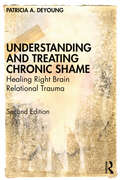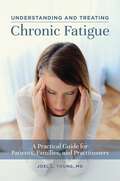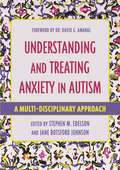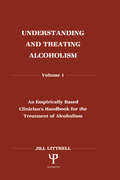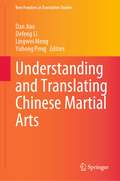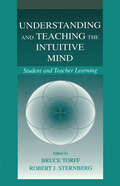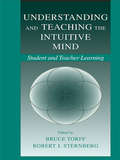- Table View
- List View
Understanding and Treating Patients in Clinical Psychoanalysis: Lessons from Literature (Psychoanalysis in a New Key Book Series)
by Sandra BuechlerUnderstanding and Treating Patients in Clinical Psychoanalysis: Lessons from Literature describes the problematic ways people learn to cope with life’s fundamental challenges, such as maintaining self-esteem, bearing loss, and growing old. People tend to deal with the challenges of being human in characteristic, repetitive ways. Descriptions of these patterns in diagnostic terms can be at best dry, and at worst confusing, especially for those starting training in any of the clinical disciplines. To try to appeal to a wider audience, this book illustrates each coping pattern using vivid, compelling fiction whose characters express their dilemmas in easily accessible, evocative language. Sandra Buechler uses these examples to show some of the ways we complicate our lives and, through reimagining different scenarios for these characters, she illustrates how clients can achieve greater emotional health and live their lives more productively. Drawing on the work of Dostoevsky, Tolstoy, Munro, Mann, James, O’Connor, Chopin, McCullers, Carver, and the many other authors represented here, Buechler shows how their keen observational short fiction portrays self-hurtful styles of living. She explores how human beings cope using schizoid, paranoid, grandiose, hysteric, obsessive, and other defensive styles. Each is costly, in many senses, and each limits the possibility for happiness and fulfillment. Understanding and Treating Patients in Clinical Psychoanalysis offers insights into what living with and working with problematic behaviors really means through a series of examples of the major personality disorders as portrayed in literature. Through these fictitious examples, clinicians and trainees, and undergraduate and graduate students can gain a greater understanding of how someone becomes paranoid, schizoid, narcissistic, obsessive, or depressive, and how that affects them, and those around them, including the mental health professionals who work with them.
Understanding and Treating Patients in Clinical Psychoanalysis: Lessons from Literature (Psychoanalysis in a New Key Book Series)
by Sandra BuechlerUnderstanding and Treating Patients in Clinical Psychoanalysis: Lessons from Literature describes the problematic ways people learn to cope with life’s fundamental challenges, such as maintaining self-esteem, bearing loss, and growing old. People tend to deal with the challenges of being human in characteristic, repetitive ways. Descriptions of these patterns in diagnostic terms can be at best dry, and at worst confusing, especially for those starting training in any of the clinical disciplines. To try to appeal to a wider audience, this book illustrates each coping pattern using vivid, compelling fiction whose characters express their dilemmas in easily accessible, evocative language. Sandra Buechler uses these examples to show some of the ways we complicate our lives and, through reimagining different scenarios for these characters, she illustrates how clients can achieve greater emotional health and live their lives more productively. Drawing on the work of Dostoevsky, Tolstoy, Munro, Mann, James, O’Connor, Chopin, McCullers, Carver, and the many other authors represented here, Buechler shows how their keen observational short fiction portrays self-hurtful styles of living. She explores how human beings cope using schizoid, paranoid, grandiose, hysteric, obsessive, and other defensive styles. Each is costly, in many senses, and each limits the possibility for happiness and fulfillment. Understanding and Treating Patients in Clinical Psychoanalysis offers insights into what living with and working with problematic behaviors really means through a series of examples of the major personality disorders as portrayed in literature. Through these fictitious examples, clinicians and trainees, and undergraduate and graduate students can gain a greater understanding of how someone becomes paranoid, schizoid, narcissistic, obsessive, or depressive, and how that affects them, and those around them, including the mental health professionals who work with them.
Understanding and Treating Obsessive-Compulsive Disorder: A Cognitive Behavioral Approach
by Jonathan S. AbramowitzAmong the most prevalent and personally devastating psychological disorders the development of a cognitive approach to obsessive compulsive disorder (OCD) has transformed our understanding and treatment of it. In this highly practical and accessible book, Jonathan Abramowitz presents a model of OCD grounded in the most up-to-date research that incorporates both cognitive and behavioral processes. He then offers a step-by-step guide to psychological treatment that integrates psychoeducation, cognitive techniques, and behavioral therapy (exposure and response prevention). Unlike other manuals for the treatment of OCD, this book teaches the reader how to tailor the choice of techniques and delivery modes for individuals presenting with a wide range of specific OCD symptoms, such as contamination fears and cleaning rituals, fears of harm and compulsive checking, symmetry and ordering, and severe obsessions with mental rituals. The techniques are illustrated with numerous case examples; clinical forms and handouts are provided for use with patients. A final chapter suggests strategies for overcoming common obstacles in treatment.
Understanding and Treating Obsessive-Compulsive Disorder: A Cognitive Behavioral Approach
by Jonathan S. AbramowitzAmong the most prevalent and personally devastating psychological disorders the development of a cognitive approach to obsessive compulsive disorder (OCD) has transformed our understanding and treatment of it. In this highly practical and accessible book, Jonathan Abramowitz presents a model of OCD grounded in the most up-to-date research that incorporates both cognitive and behavioral processes. He then offers a step-by-step guide to psychological treatment that integrates psychoeducation, cognitive techniques, and behavioral therapy (exposure and response prevention). Unlike other manuals for the treatment of OCD, this book teaches the reader how to tailor the choice of techniques and delivery modes for individuals presenting with a wide range of specific OCD symptoms, such as contamination fears and cleaning rituals, fears of harm and compulsive checking, symmetry and ordering, and severe obsessions with mental rituals. The techniques are illustrated with numerous case examples; clinical forms and handouts are provided for use with patients. A final chapter suggests strategies for overcoming common obstacles in treatment.
Understanding and Treating Military Sexual Trauma (Focus on Sexuality Research)
by Kristen ZaleskiThis authoritative update presents current findings on—and clinically and ethically sound responses to—the epidemic of sexual assault in the military. It examines in powerful detail how military culture enables a pervasive subculture of sexual violence, from consistently devaluing women to blaming victims and denying them justice. The author’s dual attachment/trauma theory lens attends to a wide range of outcomes such as unit members closing ranks against survivors and the continuing impact of assault trauma on veterans’ lives. And the book’s second half critiques standard forms of treating military sexual trauma in favor of individualized therapy addressing the physical, psychological, and neurological aspects of trauma and recovery. This important volume covers: · Theory and history of sexual violence as a weapon of war.· Legal and health considerations in the aftermath of military sexual assault.· Critical distinctions between military and civilian legal response to sexual assault.· Variations in symptomology among survivors.· Specific barriers to services for male and LGBT survivors.· New and emerging treatment options for military sexual trauma/PTSD. This Second Edition of Understanding and Treating Military Sexual Trauma follows its predecessor as an essential reference on its subject for mental health clinicians treating sexual trauma in the military as well as trauma researchers, sociologists, women’s health practitioners, and university students whose focus is women’s studies, public policy, public health, social work, psychology, sociology, or political science.
Understanding and Treating Military Sexual Trauma (Focus on Sexuality Research)
by Kristen ZaleskiThis thorough analysis of sexual assault in the military examines the scope of this long-neglected issue using a lens informed by modern day attachment and trauma theories. Starting with an overview of sexual violence during wartime, it details the cultural and organizational aspects of military life--and entrenched ideas about war and masculinity--that compound military sexual trauma (MST) and reinforce barriers to treatment for women and men. The book's second half reviews empirically-supported interventions for MST survivors, recommending therapy that attends to somatic, implicit, relational based aspects of trauma processing rather than the conventional cognitive therapies currently funded in many military mental health programs. This powerful presentation, which includes sobering quotes from survivors, also raises serious questions about meeting veterans' needs, training for on- and off-base clinicians, and government funding. Included in the coverage: The history of sexual violence in war.Trauma and recovery in military culture.The neurobiology of trauma.A military rape sub-culture hypothesis about the hidden sexual assault epidemic.How military culture and military law affect the immediate aftermath of MST.Treating the trauma and not just the memory.Questions the “one size fits all” approach of many trauma therapies for MST.Top-down cognitive-based treatment for MST.Body-based bottom-up psychotherapy for MST.Understanding and Treating Military Sexual Trauma belongs in the libraries of private practice clinicians and government psychologists. It provides cutting edge knowledge to practitioners in training, such as graduate-level students studying psychology and social work. Its dual emphasis on military culture and women's lives will appeal to students in gender studies, sociology and program planning disciplines.
Understanding and Treating Incels: Case Studies, Guidance, and Treatment of Violence Risk in the Involuntary Celibate Community
by Brian Van Brunt Chris TaylorUnderstanding and Treating Incels is an indispensable guide for mental health clinical staff, social workers, prevention specialists, educators, and threat assessment professionals who want to better understand the involuntary celibate movement, assess individuals’ potential for violence, and offer treatment approaches and prevention efforts. Chapters explore the movement in terms of gender, technology, the media, and pornography usage. The book discusses how the incel mentality has motivated individuals to misogynistic worldviews and increased rage and disillusionment, and inspired acts of targeted violence such as school shootings and mass casualty events. Later chapters walk the reader through three cases studies and offer treatment considerations to assist mental health professionals and those developing education and prevention-based programming. The complete text gives the reader useful perspectives and insights into incel culture while offering mental health clinicians and educators guidance on treatment and prevention efforts.
Understanding and Treating Incels: Case Studies, Guidance, and Treatment of Violence Risk in the Involuntary Celibate Community
by Brian Van Brunt Chris TaylorUnderstanding and Treating Incels is an indispensable guide for mental health clinical staff, social workers, prevention specialists, educators, and threat assessment professionals who want to better understand the involuntary celibate movement, assess individuals’ potential for violence, and offer treatment approaches and prevention efforts. Chapters explore the movement in terms of gender, technology, the media, and pornography usage. The book discusses how the incel mentality has motivated individuals to misogynistic worldviews and increased rage and disillusionment, and inspired acts of targeted violence such as school shootings and mass casualty events. Later chapters walk the reader through three cases studies and offer treatment considerations to assist mental health professionals and those developing education and prevention-based programming. The complete text gives the reader useful perspectives and insights into incel culture while offering mental health clinicians and educators guidance on treatment and prevention efforts.
Understanding and Treating Hot Flashes in Menopause with Chinese Medicine
by Dr. Brian GrosamUnderstanding and Treating Hot Flashes in Menopause with Chinese Medicine is the first book in history to be written on the subject. This book combines Chinese medicine concepts with current Western medicine frameworks of science and understanding of patho-mechanisms for a contemporary treatment approach to hot flashes in menopause.Dr Grosam explores both Western biomedicine - including the roles of estrogen and neurotransmitters - and Chinese medicine historical theory to provide an up-to-date understanding of hot flashes and menopausal transition. Exploring current treatments in Western medicine as well as acupuncture and herbs, he presents a complete evaluation of how modern treatment strategies can be improved through an integrated approach.Allowing for a deeper understanding of the causes of hot flashes in menopause, this book opens doors to fresh approaches and treatment strategies for women's healthcare practitioners from both branches of medicine.
Understanding and Treating Dissociative Identity Disorder (or Multiple Personality Disorder)
by Jo L. RingroseThis book provides all of the information a practitioner needs in order to begin work with clients with Dissociative Identity Disorder (DID). Drawing on experiences from her own practice and extensive research conducted with the help of internationally acclaimed experts in the field, the author describes the development of DID and the structure of the personality of these clients. The reader is guided through the assessment process, the main phases and components of treatment, and the issues and contentions that may arise in this work. Throughout the text there are case examples, practical exercises, techniques, and strategies that can be used in therapy sessions. The resources section includes screening and assessment instruments, as well as information on techniques for managing anxiety and self harm, both of which can be major problems when working with clients with DID.
Understanding and Treating Dissociative Identity Disorder (or Multiple Personality Disorder)
by Jo L. RingroseThis book provides all of the information a practitioner needs in order to begin work with clients with Dissociative Identity Disorder (DID). Drawing on experiences from her own practice and extensive research conducted with the help of internationally acclaimed experts in the field, the author describes the development of DID and the structure of the personality of these clients. The reader is guided through the assessment process, the main phases and components of treatment, and the issues and contentions that may arise in this work. Throughout the text there are case examples, practical exercises, techniques, and strategies that can be used in therapy sessions. The resources section includes screening and assessment instruments, as well as information on techniques for managing anxiety and self harm, both of which can be major problems when working with clients with DID.
Understanding and Treating Dissociative Identity Disorder: A Relational Approach (Relational Perspectives Book Series)
by Elizabeth F. HowellBuilding on the comprehensive theoretical model of dissociation elegantly developed in The Dissociative Mind, Elizabeth Howell makes another invaluable contribution to the clinical understanding of dissociative states with Understanding and Treating Dissociative Identity Disorder. Howell, working within the realm of relational psychoanalysis, explicates a multifaceted approach to the treatment of this fascinating yet often misunderstood condition, which involves the partitioning of the personality into part-selves that remain unaware of one another, usually the result of severely traumatic experiences. Howell begins with an explication of dissociation theory and research that includes the dynamic unconscious, trauma theory, attachment, and neuroscience. She then discusses the identification and diagnosis of Dissociative Identity Disorder (DID) before moving on to outline a phase-oriented treatment plan, which includes facilitating a multileveled co-constructed therapeutic relationship, emphasizing the multiplicity of transferences, countertransferences, and kinds of potential enactments. She then expands the treatment possibilities to include dreamwork, before moving on to discuss the risks involved in the treatment of DID and how to mitigate them. All concepts and technical approaches are permeated with rich clinical examples.
Understanding and Treating Dissociative Identity Disorder: A Relational Approach (Relational Perspectives Book Series)
by Elizabeth F. HowellBuilding on the comprehensive theoretical model of dissociation elegantly developed in The Dissociative Mind, Elizabeth Howell makes another invaluable contribution to the clinical understanding of dissociative states with Understanding and Treating Dissociative Identity Disorder. Howell, working within the realm of relational psychoanalysis, explicates a multifaceted approach to the treatment of this fascinating yet often misunderstood condition, which involves the partitioning of the personality into part-selves that remain unaware of one another, usually the result of severely traumatic experiences. Howell begins with an explication of dissociation theory and research that includes the dynamic unconscious, trauma theory, attachment, and neuroscience. She then discusses the identification and diagnosis of Dissociative Identity Disorder (DID) before moving on to outline a phase-oriented treatment plan, which includes facilitating a multileveled co-constructed therapeutic relationship, emphasizing the multiplicity of transferences, countertransferences, and kinds of potential enactments. She then expands the treatment possibilities to include dreamwork, before moving on to discuss the risks involved in the treatment of DID and how to mitigate them. All concepts and technical approaches are permeated with rich clinical examples.
Understanding and Treating Chronic Shame: A Relational/Neurobiological Approach
by Patricia A. DeYoungChronic shame is painful, corrosive, and elusive. It resists self-help and undermines even intensive psychoanalysis. Patricia A. DeYoung’s cutting-edge book gives chronic shame the serious attention it deserves, integrating new brain science with an inclusive tradition of relational psychotherapy. She looks behind the myriad symptoms of shame to its relational essence. As DeYoung describes how chronic shame is wired into the brain and developed in personality, she clarifies complex concepts and makes them available for everyday therapy practice. Grounded in clinical experience and alive with case examples, Understanding and Treating Chronic Shame is highly readable and immediately helpful. Patricia A. DeYoung’s clear, engaging writing helps readers recognize the presence of shame in the therapy room, think through its origins and effects in their clients’ lives, and decide how best to work with those clients. Therapists will find that Understanding and Treating Chronic Shame enhances the scope of their practice and efficacy with this client group, which comprises a large part of most therapy practices. Challenging, enlightening, and nourishing, this book belongs in the library of every shame-aware therapist.
Understanding and Treating Chronic Shame: A Relational/Neurobiological Approach
by Patricia A. DeYoungChronic shame is painful, corrosive, and elusive. It resists self-help and undermines even intensive psychoanalysis. Patricia A. DeYoung’s cutting-edge book gives chronic shame the serious attention it deserves, integrating new brain science with an inclusive tradition of relational psychotherapy. She looks behind the myriad symptoms of shame to its relational essence. As DeYoung describes how chronic shame is wired into the brain and developed in personality, she clarifies complex concepts and makes them available for everyday therapy practice. Grounded in clinical experience and alive with case examples, Understanding and Treating Chronic Shame is highly readable and immediately helpful. Patricia A. DeYoung’s clear, engaging writing helps readers recognize the presence of shame in the therapy room, think through its origins and effects in their clients’ lives, and decide how best to work with those clients. Therapists will find that Understanding and Treating Chronic Shame enhances the scope of their practice and efficacy with this client group, which comprises a large part of most therapy practices. Challenging, enlightening, and nourishing, this book belongs in the library of every shame-aware therapist.
Understanding and Treating Chronic Shame: Healing Right Brain Relational Trauma
by Patricia A. DeYoungA masterful synthesis of relational and attachment theory, neurobiology, and contemporary psychoanalysis, Understanding and Treating Chronic Shame has been internationally recognized as an essential text on shame. Integrating new theory about trauma, shame resilience, and self-compassion, this second edition further clarifies the relational, right-brain essence of being in and with the suffering of shame. New chapters carry theory further into praxis. In the time of a national Truth and Reconciliation Commission and a global Black Lives Matter movement, "Societies of Chronic Shame" invites therapists to deepen their awareness of collective societal trauma and of their own place within dissociated societal shame. "Three Faces of Shame" organizes the clinical wisdom of the book into clear guidelines for differential diagnosis and treatment. Lucid and compassionate, this book engages with the most profound challenges of clinical practice and touches into the depths of being human.
Understanding and Treating Chronic Shame: Healing Right Brain Relational Trauma
by Patricia A. DeYoungA masterful synthesis of relational and attachment theory, neurobiology, and contemporary psychoanalysis, Understanding and Treating Chronic Shame has been internationally recognized as an essential text on shame. Integrating new theory about trauma, shame resilience, and self-compassion, this second edition further clarifies the relational, right-brain essence of being in and with the suffering of shame. New chapters carry theory further into praxis. In the time of a national Truth and Reconciliation Commission and a global Black Lives Matter movement, "Societies of Chronic Shame" invites therapists to deepen their awareness of collective societal trauma and of their own place within dissociated societal shame. "Three Faces of Shame" organizes the clinical wisdom of the book into clear guidelines for differential diagnosis and treatment. Lucid and compassionate, this book engages with the most profound challenges of clinical practice and touches into the depths of being human.
Understanding and Treating Chronic Fatigue: A Practical Guide for Patients, Families, and Practitioners
by Joel L. YoungSome doctors still think Chronic Fatigue Syndrome is a "fake" diagnosis. In this book, Joel Young, MD, presents the research, experience, and treatments that prove otherwise.Millions of Americans experience chronic fatigue syndrome (CFS), a continuous exhaustion and a feeling comparable to that of having just run a marathon when all they have done is a daily living task, such as taking a shower or getting dressed.Doctors don't have tests for CFS, and some think it's a faux or psychological disorder. Joel Young, MD, in this heavily researched book, explains why it is a true physical illness and how it may be treated. He details how he successfully treats the symptoms, which can include severe fatigue, "brain fog," chronic pain, and sleep problems. Unlike doctors who recommend exercise, supplements, or opioid medications, Young integrates such options as long-acting stimulants, meditation, and dietary changes to reduce fatigue, as well as non-opioid drugs, medical marijuana, and self-help options including yoga for the associated chronic pain.
Understanding and Treating Chronic Fatigue: A Practical Guide for Patients, Families, and Practitioners
by Joel L. YoungSome doctors still think Chronic Fatigue Syndrome is a "fake" diagnosis. In this book, Joel Young, MD, presents the research, experience, and treatments that prove otherwise.Millions of Americans experience chronic fatigue syndrome (CFS), a continuous exhaustion and a feeling comparable to that of having just run a marathon when all they have done is a daily living task, such as taking a shower or getting dressed.Doctors don't have tests for CFS, and some think it's a faux or psychological disorder. Joel Young, MD, in this heavily researched book, explains why it is a true physical illness and how it may be treated. He details how he successfully treats the symptoms, which can include severe fatigue, "brain fog," chronic pain, and sleep problems. Unlike doctors who recommend exercise, supplements, or opioid medications, Young integrates such options as long-acting stimulants, meditation, and dietary changes to reduce fatigue, as well as non-opioid drugs, medical marijuana, and self-help options including yoga for the associated chronic pain.
Understanding and Treating Anxiety in Autism: A Multi-Disciplinary Approach (Understanding and Treating in Autism)
by Brad Ferguson Temple Grandin Karen Margolis Lucy Jane Miller Emily L. Casanova Leslie Weidenman Lauren J. Moskowitz Manuel Casanova Robert Hendren Estate Sokhadze Eva Lamina Desmond Kelly Judy Van de Water Micaela Edelson David Beversdorf Kimberly Law Kelly McCracken Barnhill Virginia Spielmann Margaret Bauman Tomoya Hirtoa Jordan Brooks June Grodin Cooper WoodwardAnxiety is a prevalent and often debilitating condition for individuals on the autism spectrum. This book promotes a multidisciplinary approach to intervention and treatment of the condition, providing professional understanding of the underlying causes and available treatments. With chapters co-authored by well-known advocates and pioneering researchers, contributors examine factors including sensory processing issues, sleep impairments and the crossover between the autonomic nervous system and immune system. The book expands upon current areas of research, including immune activation and the role of environmental toxicants, dietary and nutritional support, the treatment of gastrointestinal disorders and individualised methods of managing stress and anxiety. Providing an invaluable resource for professionals and academics seeking further insight into anxiety and autism, this book explores contemporary research and sets the groundwork for the most effective methods of treatment for individuals of all ages.
Understanding and Treating Alcoholism: Volume I: An Empirically Based Clinician's Handbook for the Treatment of Alcoholism:volume Ii: Biological, Psychological, and Social Aspects of Alcohol Consumption and Abuse
by Jill LittrellThere seems to be an abundance of "factual" information regarding alcoholism; what causes it, who is most susceptible, how it affects its victims, and how it should be treated. However, a definitive source of data supporting -- or refuting -- the numerous and diverse positions was never available. Thus, the goal of the author is to provide professionals with a solid understanding as to which "factual" statements about alcoholism are actually supported with evidence, and some of the empirically validated ways to proceed with treatment. Major methods of treatment are reviewed, and empirically based approaches are compared and contrasted with one another. Different and sometimes new focal points are explored, such as the disease concept of alcoholism, family members of alcoholics, personality characteristics, and effects of alcoholism exclusive to women. Also notable is the nearly unprecedented look into the impact of alcohol on all types of mood and behavior, rather than just on aggression -- a topic long since exhausted. A comprehensive review of literature, complemented with critiques of research, this two-volume set is a thorough, informative source of reference for anyone who seeks to further their knowledge of this often misunderstood, yet unfortunately all too common phenomenon.
Understanding and Treating Alcoholism: Volume I: An Empirically Based Clinician's Handbook for the Treatment of Alcoholism:volume Ii: Biological, Psychological, and Social Aspects of Alcohol Consumption and Abuse
by Jill LittrellThere seems to be an abundance of "factual" information regarding alcoholism; what causes it, who is most susceptible, how it affects its victims, and how it should be treated. However, a definitive source of data supporting -- or refuting -- the numerous and diverse positions was never available. Thus, the goal of the author is to provide professionals with a solid understanding as to which "factual" statements about alcoholism are actually supported with evidence, and some of the empirically validated ways to proceed with treatment. Major methods of treatment are reviewed, and empirically based approaches are compared and contrasted with one another. Different and sometimes new focal points are explored, such as the disease concept of alcoholism, family members of alcoholics, personality characteristics, and effects of alcoholism exclusive to women. Also notable is the nearly unprecedented look into the impact of alcohol on all types of mood and behavior, rather than just on aggression -- a topic long since exhausted. A comprehensive review of literature, complemented with critiques of research, this two-volume set is a thorough, informative source of reference for anyone who seeks to further their knowledge of this often misunderstood, yet unfortunately all too common phenomenon.
Understanding and Translating Chinese Martial Arts (New Frontiers in Translation Studies)
by Dan Jiao Defeng Li Lingwei Meng Yuhong PengThe present book features some introductory discussions on martial arts for the international audience and highlights in brief the complexities of translating the genre into English, often from a comparative literature perspective. Martial arts, also known as Kungfu or Wushu, refer to different families of Chinese fighting styles over many centuries. Martial arts fiction, or Wuxia literature, is a unique genre that depicts adventures of martial artists in ancient China. Understanding martial arts and the Chinese culture and philosophy behind them creates an intriguing experience, particularly, for non-Chinese readers; translating the literature into English poses unparalleled challenges for translators not only because of the culture embedded in it but also the fascinating martial arts moves and captivating names of many characters therein.
Understanding and Teaching the Intuitive Mind: Student and Teacher Learning (Educational Psychology Series)
by Bruce Torff Robert J. SternbergThe intuitive mind is a powerful force in the classroom and often an undetected one. Intuitive conceptions--knowledge or knowledge-structures that individuals acquire and use largely without conscious reflection or explicit instruction--sometimes work to facilitate learning in the classroom and other contexts. But learning may also be impeded by intuitive conceptions, and they can be difficult to dislodge as needed. The literatures in psychology and education include a large and diverse body of theory and research on intuitive conceptions, but this work is limited in some respects. This volume contributes in four ways to overcome these limitations. Understanding and Teaching the Intuitive Mind: Student and Teacher Learning: * pulls together diverse theoretical and methodological approaches to the origin, structure, function, and development of intuitive conceptions; * explores a diversity of academic disciplines--paying equal attention not only to mathematics and science, the fields in which intuitive concepts have been studied most extensively, but also to the social sciences, arts, and humanities; * explicitly links theory and research to educational implications and classroom applications; and * focuses not only on students' intuitive conceptions but also on teachers' intuitive beliefs about learning and teaching. Although the viewpoints of the contributors are diverse, they share the belief that educational practices have much to gain by systematic studies of the intuitive learner and teacher. This volume offers state-of-the-art, research-based information and support for psychologists, teacher educators, educational administrators, teachers, prospective teachers, and others who seek to develop educational practices that are cognizant of (and responsive to) the intuitive conceptions of students and teachers.
Understanding and Teaching the Intuitive Mind: Student and Teacher Learning (Educational Psychology Series)
by Bruce Torff Robert J. SternbergThe intuitive mind is a powerful force in the classroom and often an undetected one. Intuitive conceptions--knowledge or knowledge-structures that individuals acquire and use largely without conscious reflection or explicit instruction--sometimes work to facilitate learning in the classroom and other contexts. But learning may also be impeded by intuitive conceptions, and they can be difficult to dislodge as needed. The literatures in psychology and education include a large and diverse body of theory and research on intuitive conceptions, but this work is limited in some respects. This volume contributes in four ways to overcome these limitations. Understanding and Teaching the Intuitive Mind: Student and Teacher Learning: * pulls together diverse theoretical and methodological approaches to the origin, structure, function, and development of intuitive conceptions; * explores a diversity of academic disciplines--paying equal attention not only to mathematics and science, the fields in which intuitive concepts have been studied most extensively, but also to the social sciences, arts, and humanities; * explicitly links theory and research to educational implications and classroom applications; and * focuses not only on students' intuitive conceptions but also on teachers' intuitive beliefs about learning and teaching. Although the viewpoints of the contributors are diverse, they share the belief that educational practices have much to gain by systematic studies of the intuitive learner and teacher. This volume offers state-of-the-art, research-based information and support for psychologists, teacher educators, educational administrators, teachers, prospective teachers, and others who seek to develop educational practices that are cognizant of (and responsive to) the intuitive conceptions of students and teachers.









